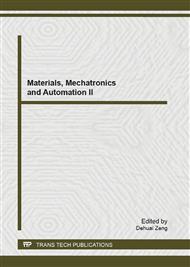p.391
p.399
p.403
p.408
p.416
p.422
p.426
p.433
p.438
Fabrication of Combined Capacitive Micromachined Ultrasound Transducers with Release Method
Abstract:
A novel combined capacitive micromachined ultrasound transducer (CMUT) with release method was proposed and fabricated with. The combined CMUT has alternating low and high-frequency elements. Several different combined patterns of CMUTs were offered. The performances of CMUTs are strongly dependent on the geometrical properties of the single cells and their arrangement within each element as well. Finite element simulations are used for analysis, design, and optimization of CMUT cells to predict device performance. Electrostatic interactions for 3-D coupled-field simulations are also performed to help investigate the electro-mechanical properties of the CMUTs. Feasibility devices are then fabricated using chromium as a sacrificial release material. The top membrane is built using a sandwich structure to ensure the formation of large size membranes with low stress.
Info:
Periodical:
Pages:
416-421
Citation:
Online since:
August 2013
Authors:
Price:
Сopyright:
© 2013 Trans Tech Publications Ltd. All Rights Reserved
Share:
Citation:


